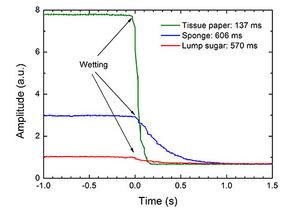Terahertz Measurements for Ultrafast Dynamics
Measuring 100 million pulses per second
- Numerous applications call for “ultrafast” terahertz measurements
- High-bandwidth Schottky detectors observe individual terahertz pulses...
- ...at repetition rates as high as 100 MHz
- This enables monitoring of dynamic processes with a sub-µs temporal resolution
- Recommended systems: TeraFlash smart
A range of applications in fundamental science call for terahertz observations at “extreme” speeds. One example involves the study of protein dynamics in water, where solved biomolecules unfold within milli- or microseconds. Spectroscopy under rapidly changing environmental conditions forms yet another active field of research: Pulsed magnets, for instance, generate intense fields which last no longer than a few milliseconds. Time-resolved measurements therefore require truly “ultrafast” methods, with data rates in the kHz to MHz range.
A photoconductive switch hooked up to a femtosecond laser produces tens of millions of terahertz pulses per second. High-bandwith Schottky diodes enable intensity measurements of each individual terahertz pulse. The combination of a powerful InGaAs emitter and a Schottky receiver has been shown to achieve measurement rates up to 100 MHz – orders of magnitude higher than conventional detection schemes based on mechanical delay stages. This enables the observation of dynamic processes with a temporal resolution as short as a ten nanoseconds.
See more in our videos:
-
Related Products
-
Related Applications
-
Related Literature
- Review paper: Naftaly, M., et al., Industrial applications of terahertz sensing: State of play, Sensors (2019)
- Publication: M. Yahyapour et al., Fastest thickness measurements with a terahertz time-domain system based on electronically controlled optical sampling; Appl. Sciences (2019)
- Publication: F. Rettich et al., Field intensity detection of individual terahertz pulses at 80 MHz repetition rate; J Infrared Milli. Terahz. Waves 36:7 (2015)
- Publication: N. Vieweg et al., Terahertz-time domain spectrometer with 90 dB peak dynamic range; J Infrared Milli. Terahz. Waves 35:10 (2014)
- Scientific Paper: S.Brinkmann et al., Towards Quality Control in Pharmaceutical Packaging: Screening Folded Boxes for Package Inserts, J Infrared Milli. Terahz. Waves (2017)
- Downloads

